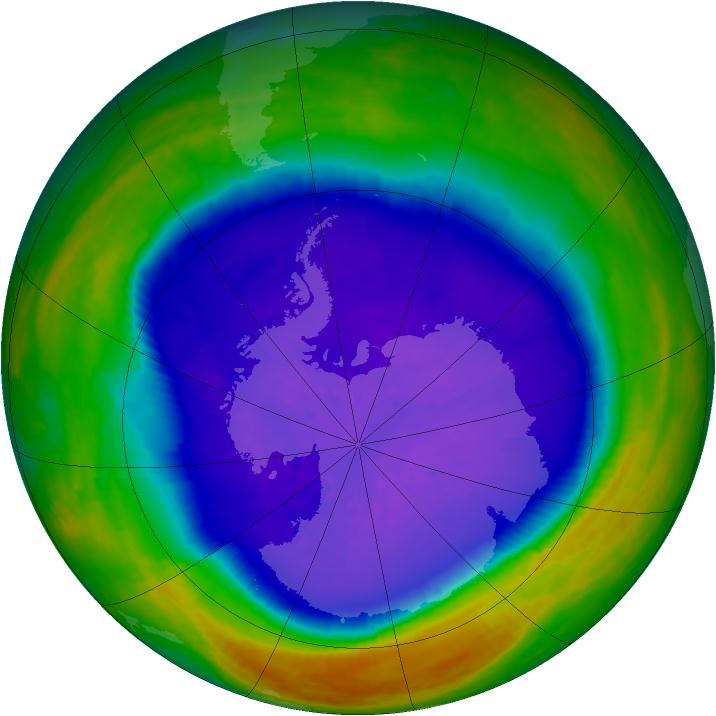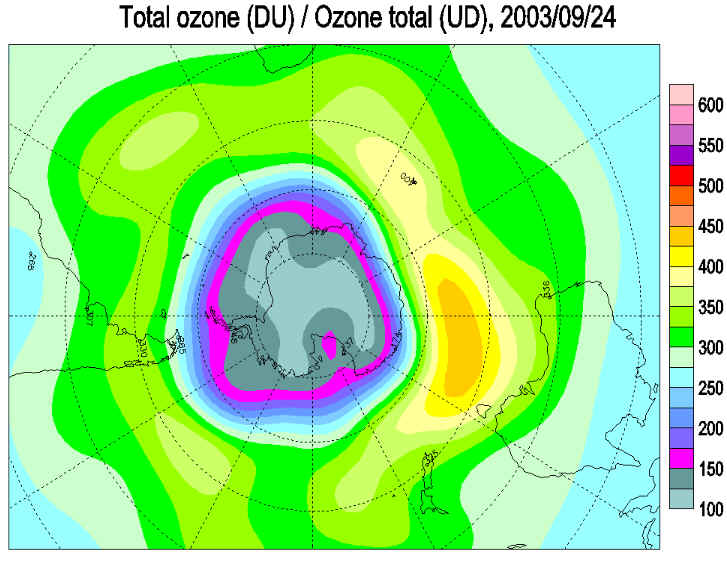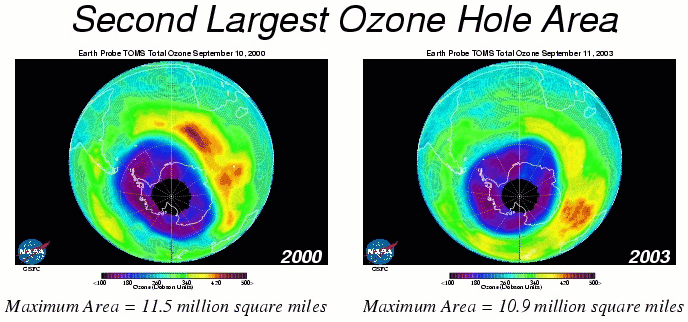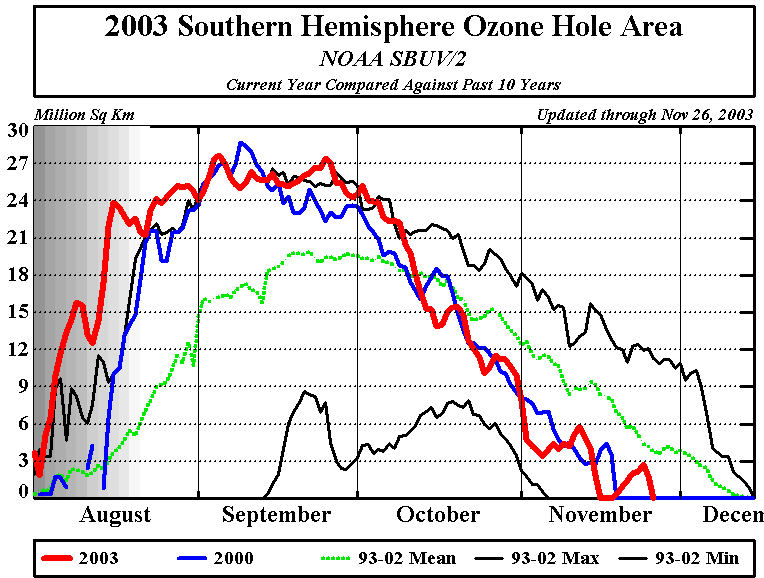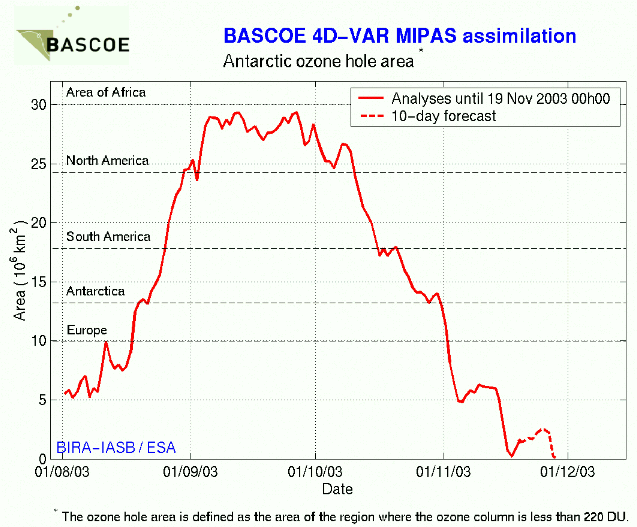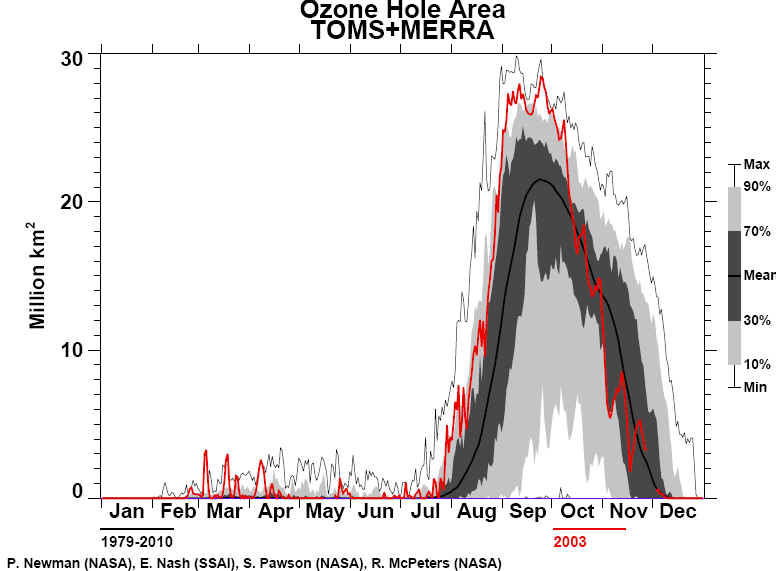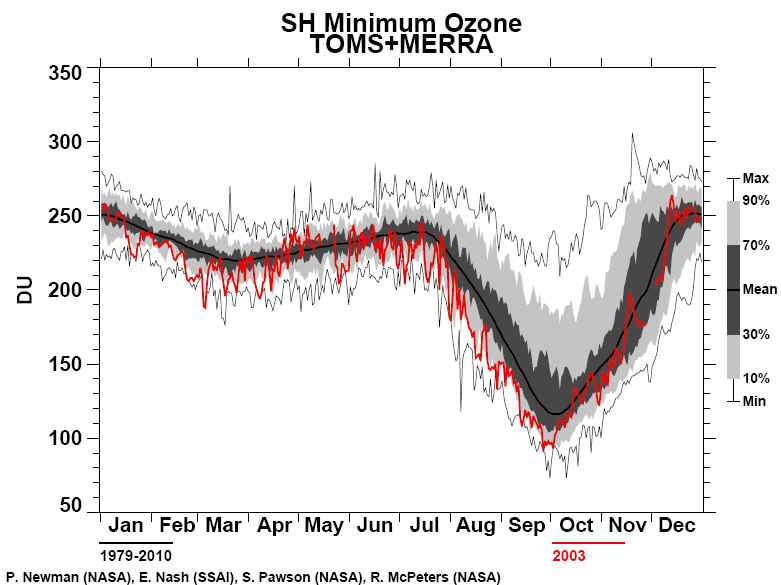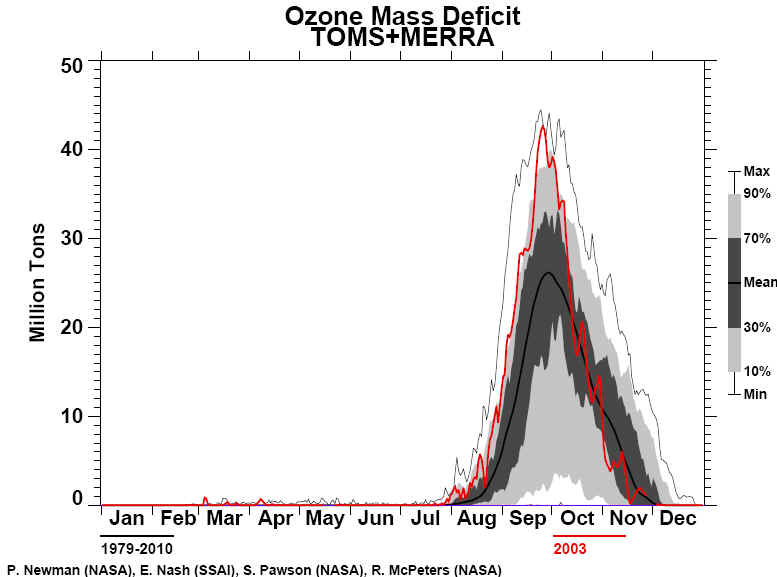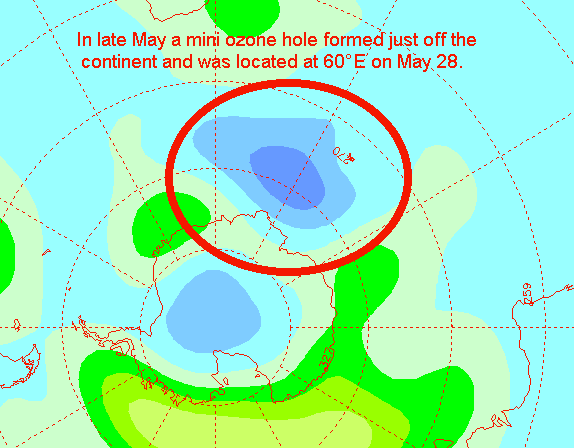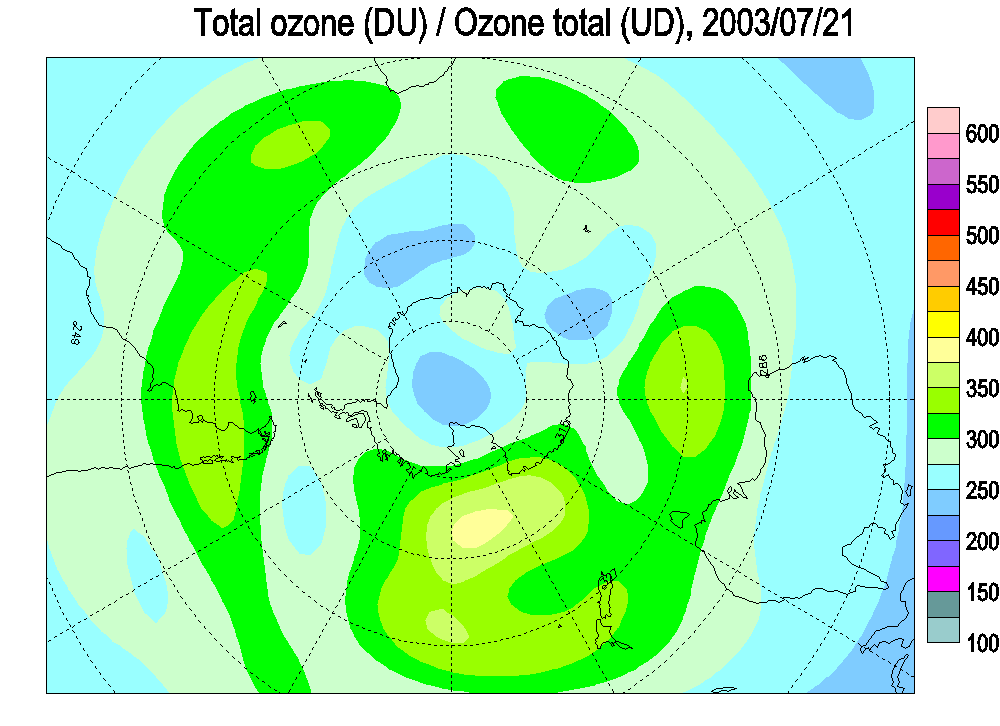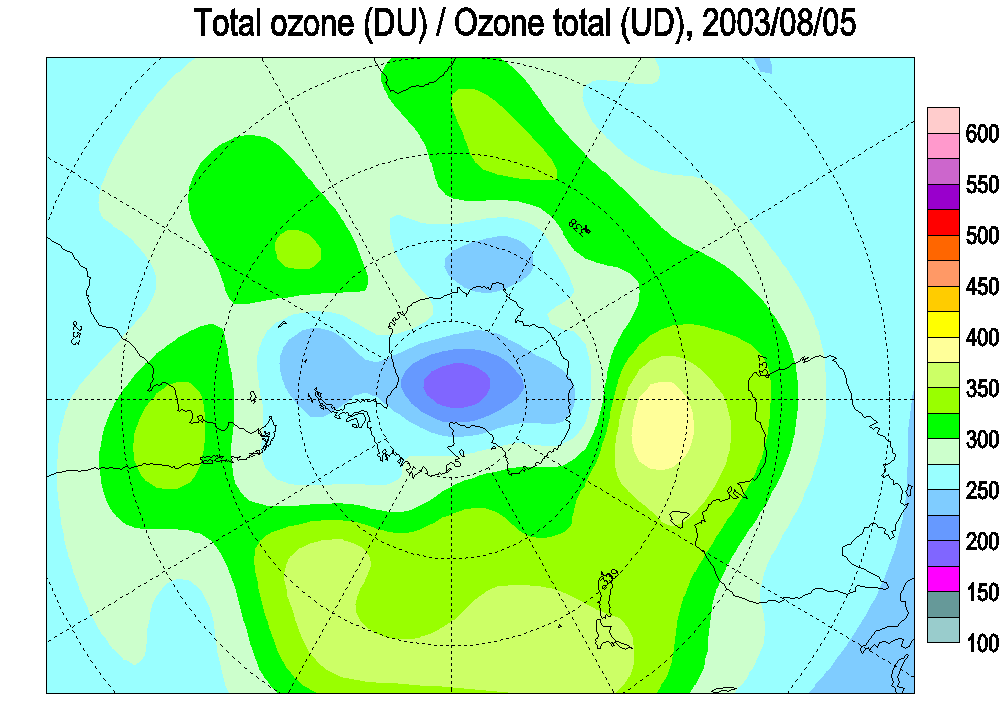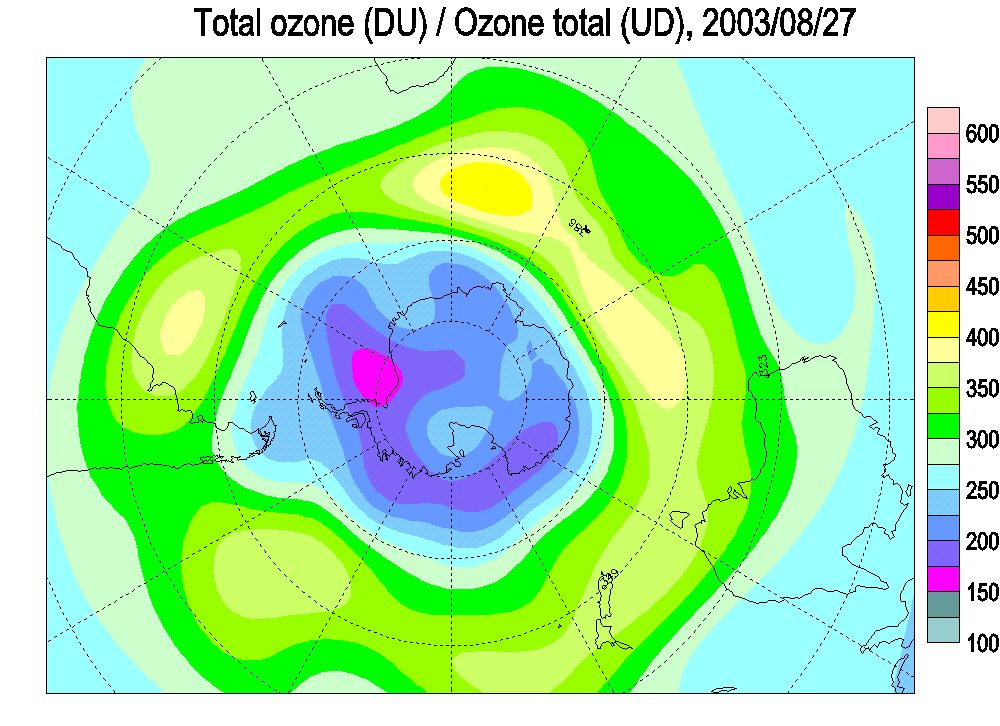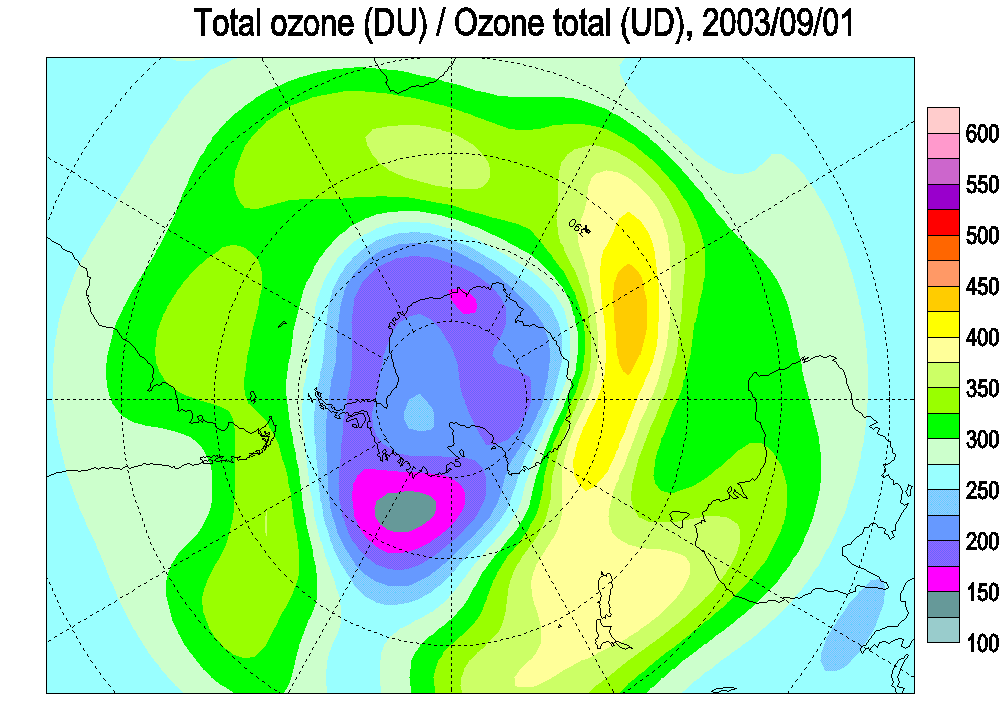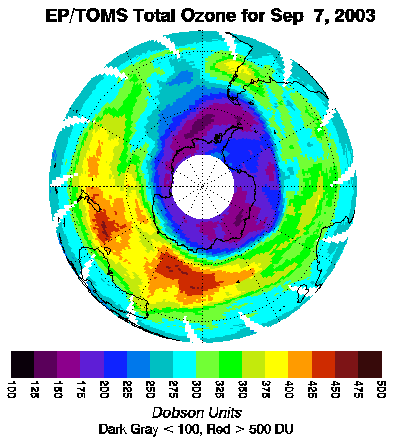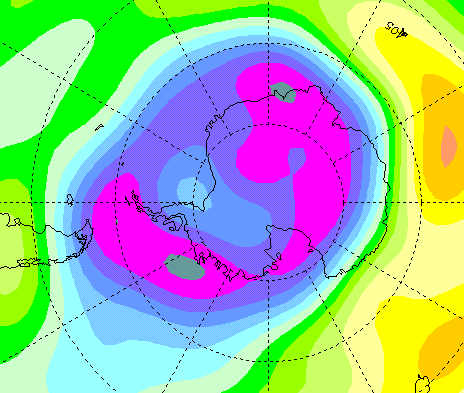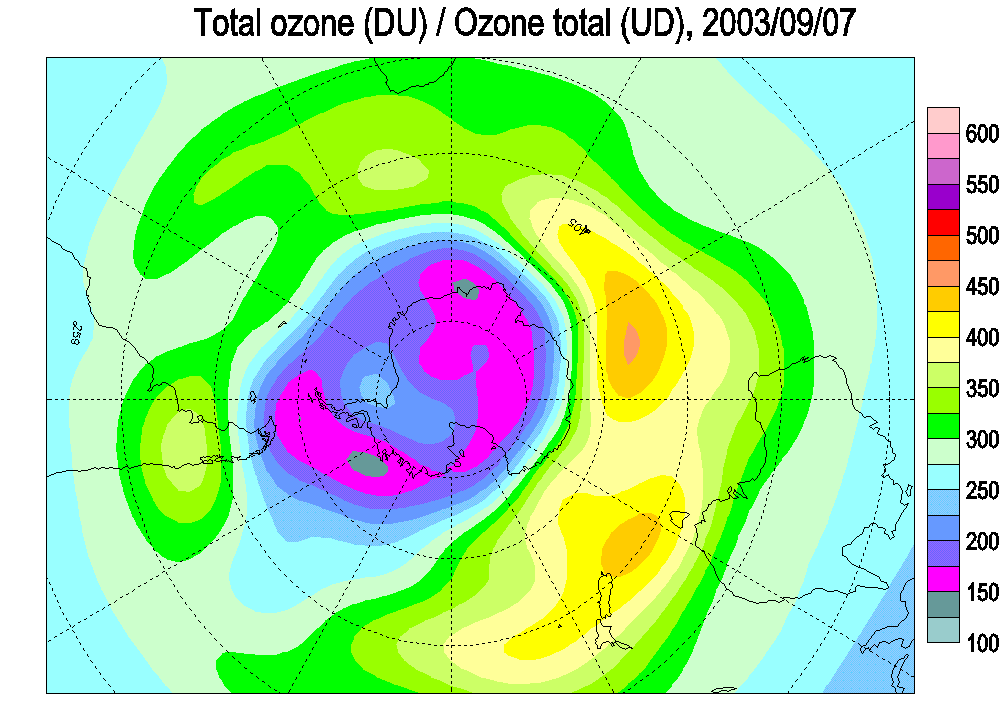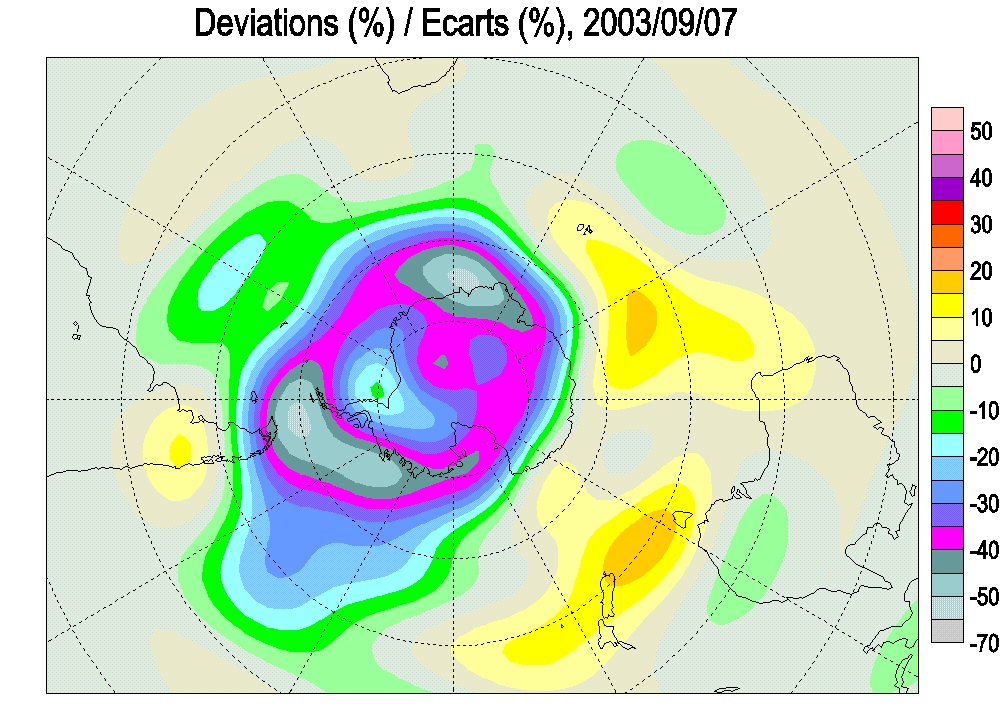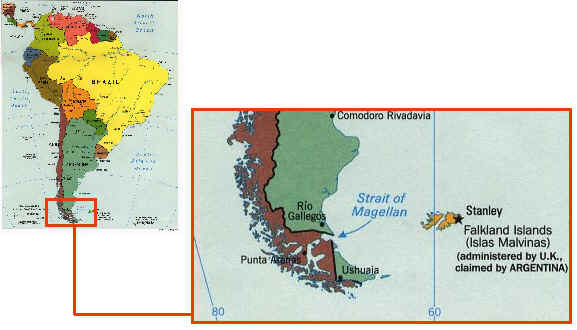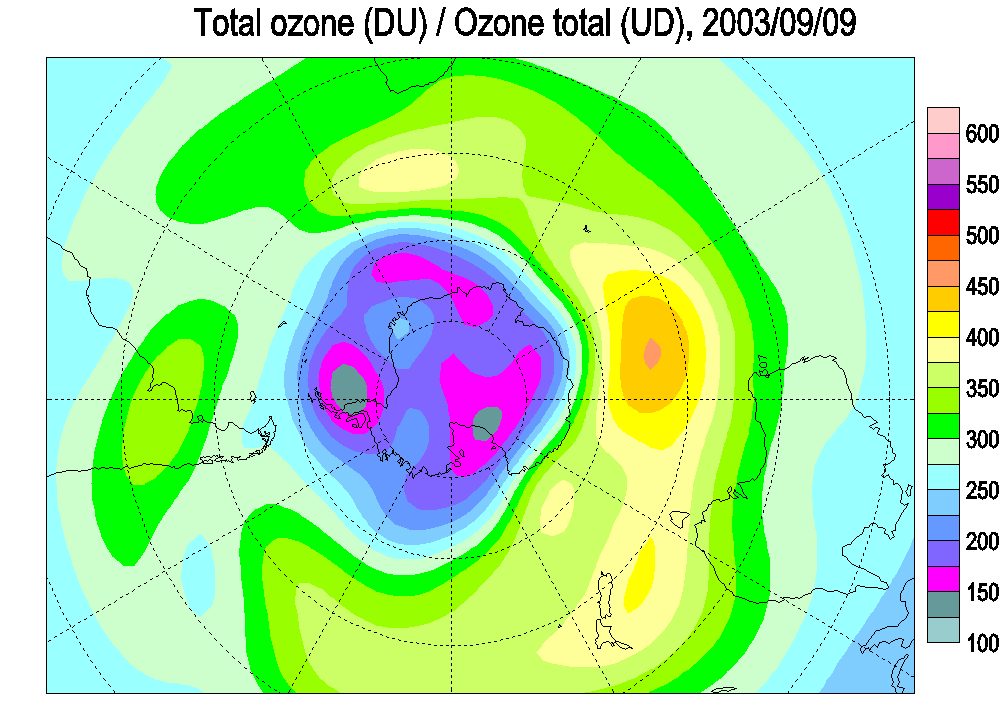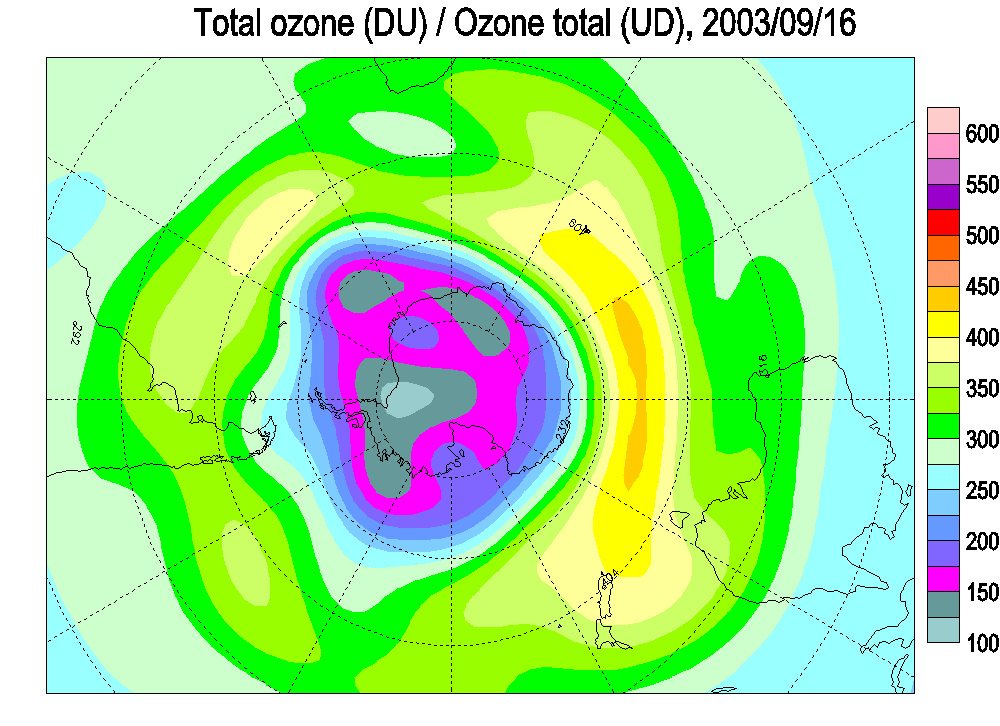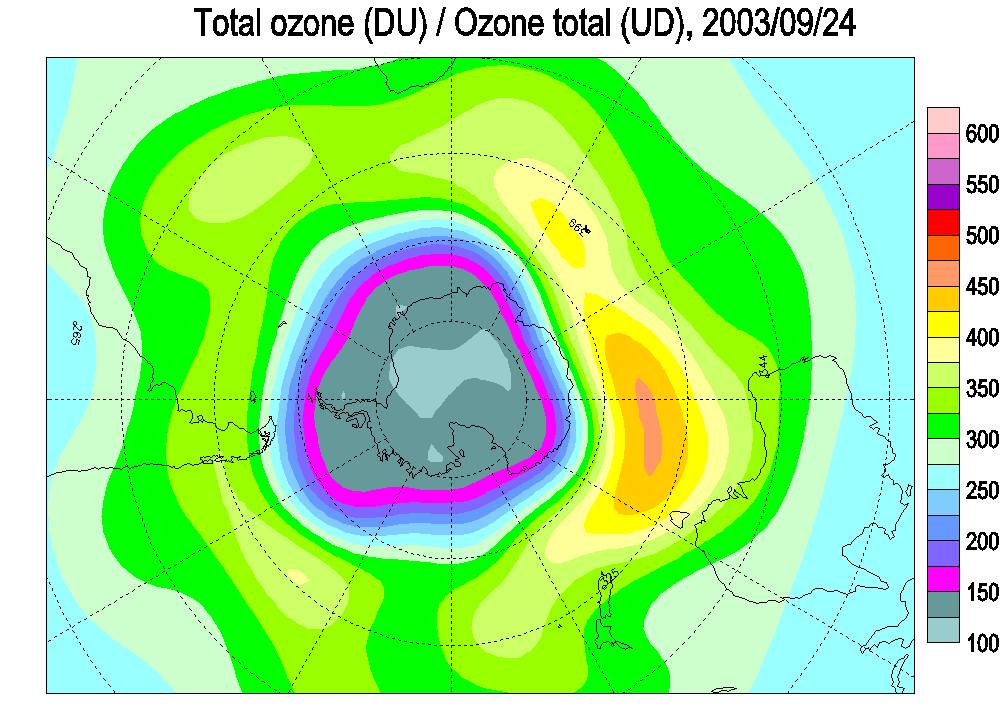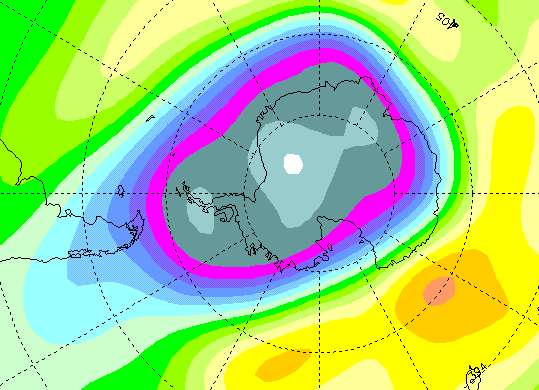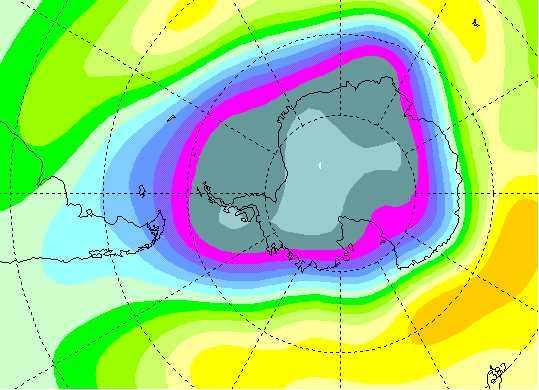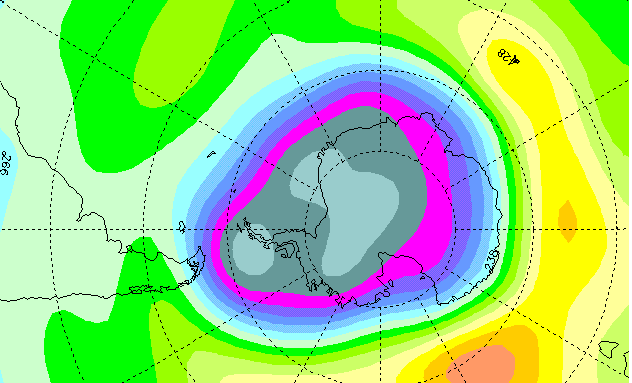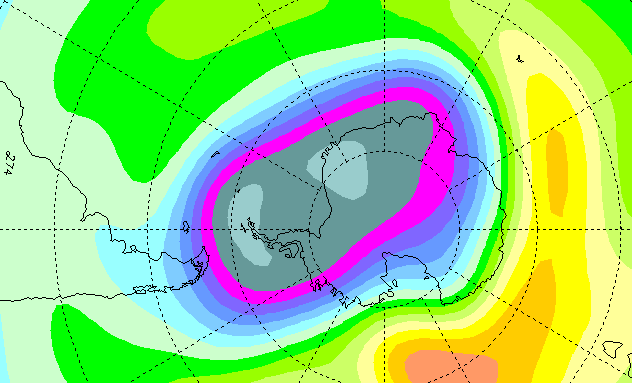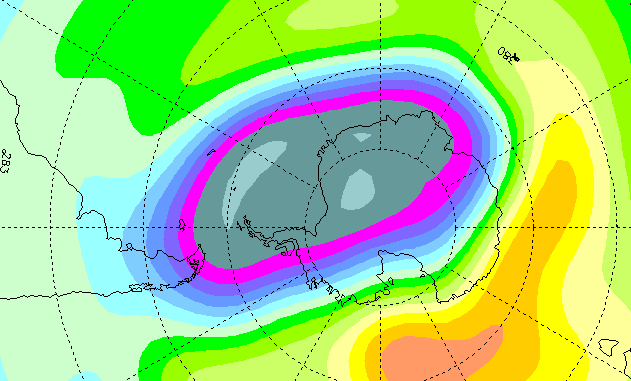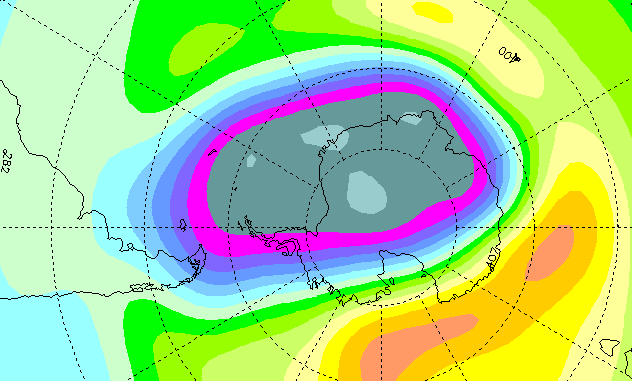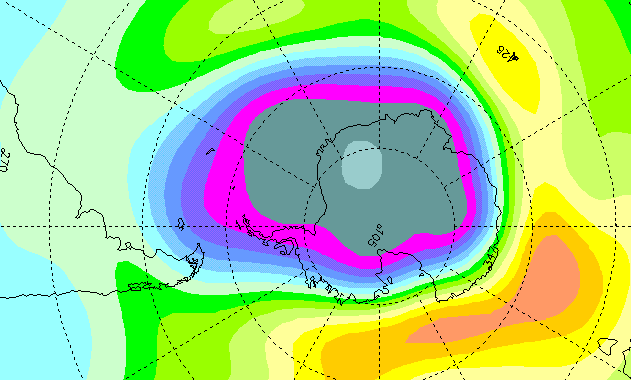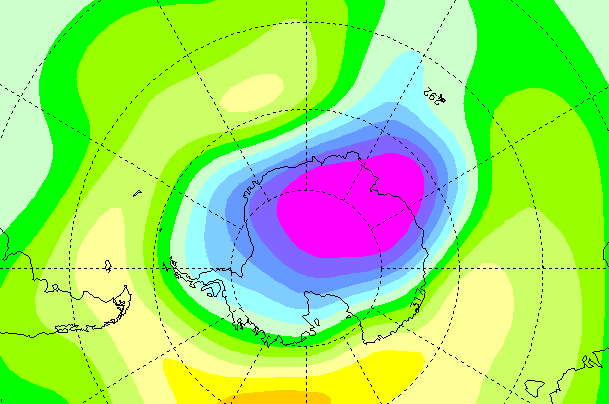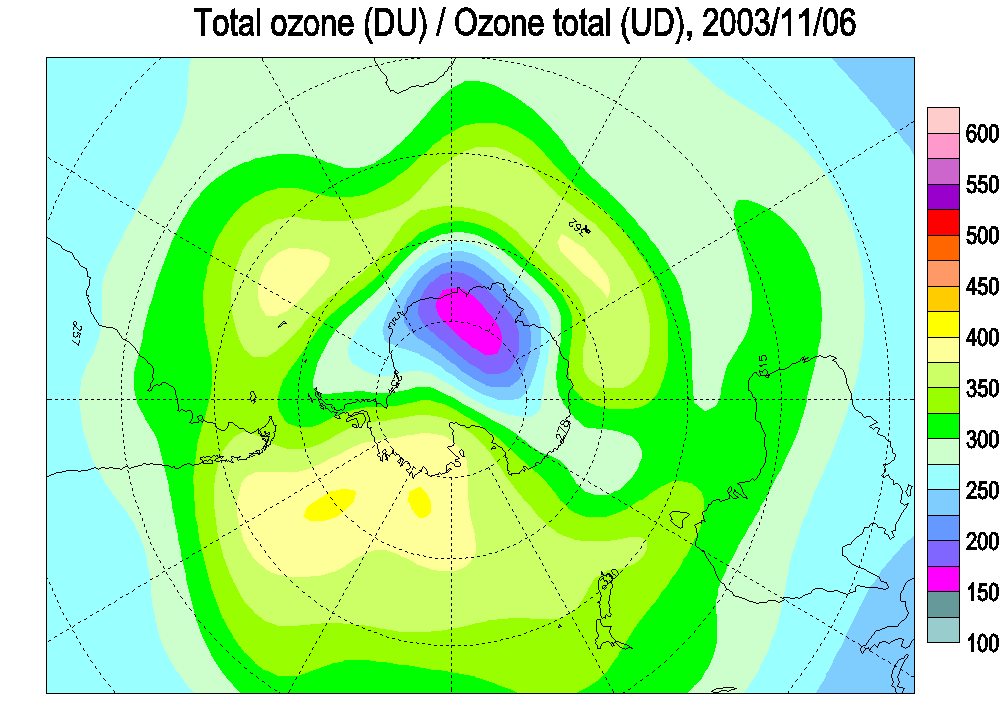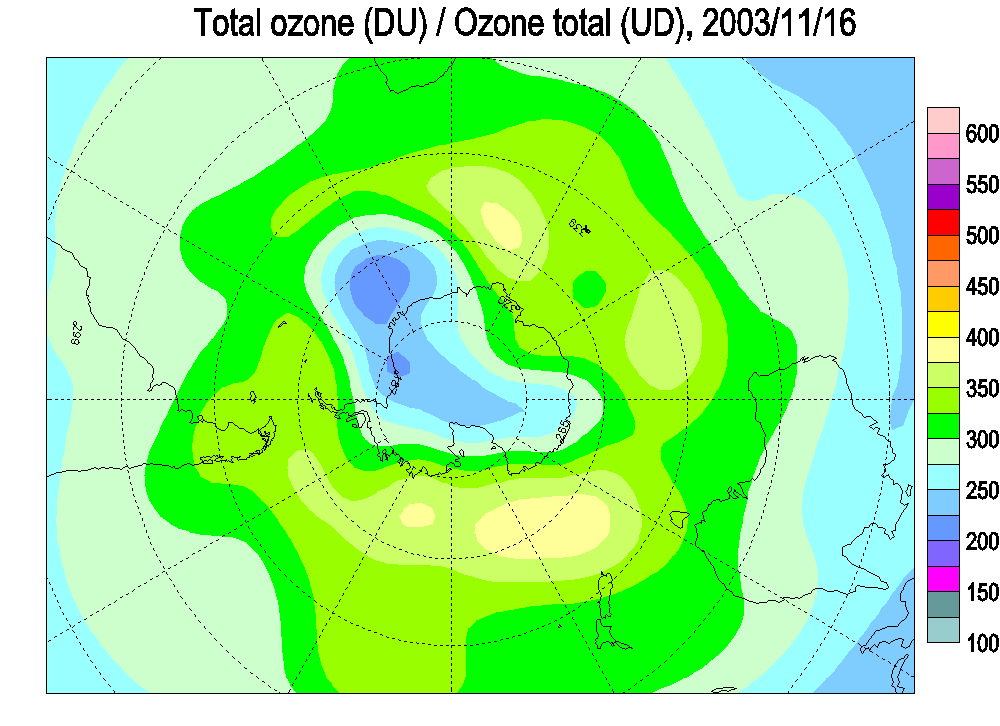|
Ozone Hole 2003
http://ozonewatch.gsfc.nasa.gov
http://www.cpc.ncep.noaa.gov/products/stratosphere/sbuv2to/ozone_hole_plot.png
http://bascoe.oma.be/index.html
2003 ANTARCTIC OZONE 'HOLE' NEAR RECORD SIZE;COLD TEMPERATURES PLAY MAJOR ROLEOct. 7, 2003 — This year's Antarctic ozone "hole" is the second largest ever observed, according to NOAA scientists. The size of the ozone depletion region shows an increase in its total size from last year, further indicating that the relatively smaller hole of 2002 was mostly a quirk of meteorological conditions over Antarctica. The difference is directly attributed to year-to-year temperature variations across the Antarctic continent, not an increase in the amount of ozone-depleting compounds in the atmosphere. "We expect to see year-to-year variations in the size of the ozone hole because stratospheric temperatures can vary from year to year. In colder years, the same amount of ozone-depleting compounds can destroy more ozone, in comparison to warmer years," said Daniel L. Albritton, director of the NOAA Aeronomy Laboratory in Boulder, Colo. The Antarctic ozone "hole" is defined as thinning of the springtime ozone layer to levels significantly below those seen prior to 1979. Extreme cold in the upper atmosphere is one key factor that affects the amount of ozone loss caused by ozone-depleting compounds. Year-to-year changes in the size and amount of depletion in the vertical column of the ozone hole are dominated by the year-to-year variations in temperature in this part of the atmosphere. Chlorine- and bromine-containing compounds from human activity are the primary cause of ozone depletion. The 1987 United Nations Montreal Protocol and its subsequent amendments sharply curtailed the use of chlorine-containing chlorofluorcarbons (CFCs) and bromine-containing halons. Because of the protocol, the amounts of these ozone-depleting substances have begun to decline in the lower atmosphere and to level off in the stratosphere, where the ozone layer resides. "Although international protocols have greatly reduced the production and release of ozone depleting chemicals, they will remain active in the stratosphere for several decades," said James Laver, director of the NOAA Climate Prediction Center. "With the protective atmospheric layer so compromised, greater amounts of ultraviolet radiation may be allowed to reach the surface and potentially increase certain health risks." NOAA provides predictions of expected levels of ultraviolet radiation in support of the Environmental Protection Agency's Sunwise program. At South Pole Station, balloon-borne ozone-measuring instruments launched by the NOAA Climate Monitoring and Diagnostics Laboratory reveal the vertical structure of the developing ozone hole. An important gauge for identifying when future recovery of the Antarctic ozone hole begins is the severity of depletion observed in the upper atmosphere near the main ozone layer. Ozone measured by a balloon instrument on Sept. 26 showed nearly complete ozone destruction in the 9-13 mile altitude layer. Total column ozone indicated a 60 per cent drop from early August measurements. "This year, ozone depletion over the South Pole, from 7-to-14 miles above Antarctica, has shown large losses, similar to losses seen in the 1990s," said Bryan Johnson of the NOAA Climate Monitoring and Diagnostics Laboratory. Ozone blocks harmful ultraviolet "B" rays. Prolonged over-exposure to ultraviolet radiation has been linked to skin cancer in humans and other adverse biological effects on plants and animals. The dramatic ozone "hole" exists only over Antarctica, but currently, the ozone layer over the United States is depleted by about 6 percent. Temperature over the Antarctic affects the formation of polar stratospheric clouds, which accelerate the destruction of stratospheric ozone by human-produced chlorine and bromine compounds. The Antarctic ozone hole is still expected to recover in about 50 years, when the atmospheric amounts of reactive chlorine and bromine return to their pre-ozone-hole levels. The observed size of the ozone depletion region in 2003 is a stark contrast from 2002. The reduced size in 2002 was attributed to warmer-than-normal stratospheric temperatures and temperature patterns above Antarctica. The size of this year's Antarctic ozone hole reached 10.9 million square miles on Sept. 11, 2003, smaller than Sept. 10, 2000, the largest ever recorded when it covered 11.5 million square miles. Last year the ozone hole was smaller, covering 8.1 million square miles. NOAA is dedicated to enhancing economic security and national safety through the prediction and research of weather and climate-related events and providing environmental stewardship of the nation?s coastal and marine resources. NOAA is part of the U.S. Department of Commerce.
Situation at 2003 May 30-British Antarctic Survey Ozone BulletinOzone values over Antarctica have declined from the late spring peak and there are lower values over the centre of the continent than over the southern ocean. Ozone values at Halley have declined from the spring peak of 350 DU to around 240 DU. In late May a mini ozone hole formed just off the continent and was located at 60°E on May 28. Although temperatures are low enough for PSCs to form over the continent, this feature is largely due to dynamical effects.
Environment Canada Southern Hemisphere Ozone Map Situation at 2003 July 21 -British Antarctic Survey Ozone Bulletin Ozone values over Antarctica are already below 200 DU, with an ozone hole affecting most of the continent. Temperatures in the ozone layer are low enough for PSCs to have formed over the continent.
Environment Canada Southern Hemisphere Ozone Map http://exp-studies.tor.ec.gc.ca/cgi-bin/selectMap?lang=e Situation at 2003 August 5 -British Antarctic Survey Ozone Bulletin Ozone values over Antarctica are already below 200 DU, with an ozone hole affecting most of the continent. Temperatures in the ozone layer are low enough for Polar Stratospheric Clouds (PSCs) to have formed over the continent.
Environment Canada Southern Hemisphere Ozone Maphttp://exp-studies.tor.ec.gc.ca/cgi-bin/selectMap?lang=e
21August03-Large ozone hole over Antarctica likely Scientists are predicting a large ozone hole over much of Antarctica this spring.- 8/21/2003-Large ozone hole over Antarctica likely Situation at 2003 August 27-British Antarctic Survey Ozone BulletinThe ozone has grown rapidly and now covers some 23 million square kilometres, larger than it has ever been at this time in August. Very low ozone levels have been recorded over the Antarctic Peninsula. Temperatures in the ozone layer are low enough that Polar Stratospheric Clouds (PSCs) have formed widely over the continent.
Environment Canada Southern Hemisphere Ozone Map http://exp-studies.tor.ec.gc.ca/cgi-bin/selectMap?lang=e
Situation at 2003 September 1-British Antarctic Survey Ozone Bulletin-The ozone has grown rapidly and now covers some 26 million square kilometres, larger than it has ever been at this time in early September. Very low ozone levels have been recorded over the Antarctic Peninsula. Temperatures in the ozone layer are low enough that Polar Stratospheric Clouds (PSCs) have formed widely over the continent.
Environment Canada Southern Hemisphere Ozone Map http://exp-studies.tor.ec.gc.ca/cgi-bin/selectMap?lang=e
Ozone Hole Reaches South America
7September03-The Ozone hole has reached land and population areas in Argentina, Chile and The Falkland Islands.
September 7,2003 Environment Canada Southern Hemisphere Ozone Map http://exp-studies.tor.ec.gc.ca/cgi-bin/selectMap?lang=e
The protective level of ozone has dropped below 200 dobson units in some areas.
Environment Canada Southern Hemisphere Ozone Map http://exp-studies.tor.ec.gc.ca/cgi-bin/selectMap?lang=e
Ozone levels are down as much as 50% in some areas.
Environment Canada Southern Hemisphere Ozone Map http://exp-studies.tor.ec.gc.ca/cgi-bin/selectMap?lang=e
Central Intelligence Agency Maps from University of Texas Map Center The area and population affected including the Argentinean city of Ushaia which has a population of 30,000 and Punta Arenas, Chile which has a population of 120,000 are all at risk during this time period. The public should avoid going outside during the peak hours of 11:00 a.m. and 3:00 p.m. to avoid exposure to the UV rays. If people do go outside during these hours they should wear protective sunscreen and if possible a hat or head covering and sunglasses with a uv rating. The Ozone hole has reached land and population areas in Argentina, Chile and The Falkland Islands since the early 1990's. Ozone levels drop down as much as 70% in some areas. The protective level of ozone has dropped below 150 dobson units in some areas. It has reached further north at times affecting the towns of Rio Gallegos, Puerto Santa Cruz, and Rio Grande affecting an additional 200,000 people.
Situation at 2003 September 9-British Antarctic Survey Ozone Bulletin-The ozone has grown rapidly and now covers some 28 million square kilometres, larger than it has ever been at this time in early September. Very low ozone levels have been recorded over the Antarctic Peninsula. Temperatures in the ozone layer are low enough that Polar Stratospheric Clouds (PSCs), the key precursors to significant ozone depletion, have formed widely over the continent.
Environment Canada Southern Hemisphere Ozone Map http://exp-studies.tor.ec.gc.ca/cgi-bin/selectMap?lang=e
Situation at 2003 September 12-British Antarctic Survey Ozone Bulletin-The ozone has grown rapidly and now covers some 27 million square kilometres, larger than it has ever been at this time in early September. Very low ozone levels have been recorded over the Antarctic Peninsula. The edge of the ozone hole touched the tip of South America on September 6 - 7. Temperatures in the ozone layer are low enough that Polar Stratospheric Clouds (PSCs), the key precursors to significant ozone depletion, have formed widely over the continent and ozone levels are dropping quickly.
The British Antarctic Survey (BAS) Press release-Published: 12 Sep 2003 BA Festival of Science - The Ozone Hole 14.00 – 17.00. Lecture Theatre B03, Peel Building, University of Salford Embargo – 09.30 hrs
12 September 2003 11 Sept 2003 PR No.9/2003 http://www.antarctica.ac.uk
Satellite observations (NOAA) suggest that this year's ozone hole is so far one of the biggest on record. The annual ‘hole’ has grown rapidly during August and now covers some 27 million square kilometres, larger than it has ever been at this time in early September. At the British Antarctic Survey’s Halley Research Station ground-based ozone observations have commenced with the return of sunlight. These initial values are around 40% down on those measured before the ozone ‘hole’ and are comparable to those over the last decade. Speaking at the British Association Annual Science Festival, Dr Alan Rodger of BAS said, “We think we are turning the corner but we predict that it will be a decade or more before we can say unambiguously that the ozone hole is recovering - assuming that the decline in ozone depleting chemicals continues. Last year's smaller ozone hole should be regarded as exceptional and was clearly a one off event in the record so far.” Recent measurements at ground-based monitoring stations around the world show that the loading of ozone destroying chemicals at the surface has been dropping since about 1994 and is now about 6% down on that peak. The stratosphere, on the other hand, lags behind the surface by several years and the loading of ozone depleting chemicals in the ozone layer is at or near its peak. Satellite measurements show that although the rate of decline in ozone amount in the upper stratosphere is slowing, the total ozone amount is still declining.
Situation at 2003 September 16-British Antarctic Survey Ozone Bulletin- The ozone has grown rapidly and is now near its maximum size at around 26 million square kilometres (roughly twice the size of Antarctica). It was larger than previously for the time of year in August and early September, but is a little smaller than the all time record. Very low ozone levels have been recorded over the Antarctic Peninsula. The edge of the ozone hole touched the tip of South America on September 6 - 7. Temperatures in the ozone layer are low enough that Polar Stratospheric Clouds (PSCs), the key precursors to significant ozone depletion, have formed widely over the continent and ozone levels are dropping quickly. The ozone hole is usually largest in early September and deepest in late September to early October. September 16 is world ozone day.
International Day for the Preservation of the Ozone Layer September 16- On 19 December 1994, the United Nations General Assembly proclaimed 16 September the International Day for the Preservation of the Ozone Layer, commemorating the date, in 1987, on which the Montreal Protocol on Substances that Deplete the Ozone Layer was signed (resolution 49/114). States are invited to devote the Day each year to promote, at the national level, activities in accordance with the objectives of the Montreal Protocol and its amendments. The following present and past materials and information can be used by governments, industry and individuals to help celebrate Ozone Day. http://www.unep.org/ozone/ozone_day2003/index.shtml
Situation at 2003 September 22-British Antarctic Survey Ozone Bulletin- The ozone hole has grown rapidly and peaked in size at around 28 million square kilometres (roughly twice the size of Antarctica) in mid September. It was larger than previously for the time of year in August and early September, but the maximum size only equalled the all time record. Very low ozone levels have been recorded over the Antarctic Peninsula. The edge of the ozone hole touched the tip of South America on September 6 - 7. Temperatures in the ozone layer are low enough that Polar Stratospheric Clouds (PSCs), the key precursors to significant ozone depletion, have formed widely over the continent and ozone levels are dropping quickly. The ozone hole is usually largest in early September and deepest in late September to early October.
9/22/2003-Media release: 22 September 2003 | Antarctic ozone hole – near record levels | Measurements by National Institute of Water & Atmospheric Research (NIWA) staff at Scott Base, Antarctica- Antarctic ozone hole - near record levels
Situation at 2003 September 25-British Antarctic Survey Ozone Bulletin- Temperatures in the ozone layer are low enough that Polar Stratospheric Clouds (PSCs), the key precursors to significant ozone depletion, have formed widely over the continent. Ozone levels dropped quickly during August and September with the return of sunlight and depletion exceeds 55% in places. The ozone hole grew rapidly and peaked in size at around 28 million square kilometres (roughly twice the size of Antarctica) in mid September. It was larger than previously for the time of year in August and early September, but the maximum size only equalled the all time record. Ozone sonde flights from Rothera show substantial depletion between 12 and 23 kilometres, with effectively 100% depletion at times at some altitudes.
25September3-2003 Ozone 'Hole' Approaches, But Falls Short of Record This year's Antarctic ozone hole is the second largest ever observed, according to scientists from NASA, the National Oceanic and Atmospheric Administration (NOAA), and the Naval Research Laboratory (NRL). Full Story Click here
29September03-The Ozone hole has again reached land and population areas in Argentina, Chile and The Falkland Islands.
Central Intelligence Agency Maps from University of Texas Map Center The protective level of ozone has dropped below 200 dobson units in some areas.
Environment Canada Southern Hemisphere Ozone Map 9/29/03 http://exp-studies.tor.ec.gc.ca/cgi-bin/selectMap?lang=e The area and population affected are the Argentinean city of Ushaia which has a population of 30,000 and Punta Arenas, Chile which has a population of 120,000 and the towns of Rio Gallegos, Puerto Santa Cruz, and Rio Grande affecting an additional 200,000 people .
Environment Canada Southern Hemisphere Ozone Map 9/30/03 http://exp-studies.tor.ec.gc.ca/cgi-bin/selectMap?lang=e The public should avoid going outside during the peak hours of 11:00 a.m. and 3:00 p.m. to avoid exposure to the UV rays. If people do go outside during these hours they should wear protective sunscreen and if possible a hat or head covering and sunglasses with a uv rating. The Ozone hole has reached land and population areas in Argentina, Chile and The Falkland Islands since the early 1990's. Ozone levels drop down as much as 70% in some areas. The protective level of ozone has dropped below 150 dobson units in some areas.
Situation at 2003 October 1 British Antarctic Survey Ozone Bulletin- Temperatures in the ozone layer remain low enough that Polar Stratospheric Clouds (PSCs), the key precursors to significant ozone depletion, exist widely over the continent. Ozone levels dropped quickly during August and September with the return of sunlight and depletion now exceeds 60% in places with small areas registering below 100 DU. The ozone hole grew rapidly and peaked in size at around 28 million square kilometres (roughly twice the size of Antarctica) in mid September. It was larger than previously for the time of year in August and early September, but the maximum size only equalled the all time record. Ozone sonde flights from Rothera show substantial depletion between 12 and 24 kilometres, with 100% depletion at times at some altitudes. The edge of the ozone hole touched the tip of South America and the Falkland Islands over September 27 - 30. 08October03-The Ozone hole has again reached land and population areas in Argentina, Chile and The Falkland Islands.
Environment Canada Southern Hemisphere Ozone Map 10/04/03 http://exp-studies.tor.ec.gc.ca/cgi-bin/selectMap?lang=e
The protective level of ozone has dropped below 200 dobson units in some areas.
Environment Canada Southern Hemisphere Ozone Map 10/05/03 http://exp-studies.tor.ec.gc.ca/cgi-bin/selectMap?lang=e
Environment Canada Southern Hemisphere Ozone Map 10/06/03 http://exp-studies.tor.ec.gc.ca/cgi-bin/selectMap?lang=e
Environment Canada Southern Hemisphere Ozone Map 10/07/03 http://exp-studies.tor.ec.gc.ca/cgi-bin/selectMap?lang=e The public should avoid going outside during the peak hours of 11:00 a.m. and 3:00 p.m. to avoid exposure to the UV rays. If people do go outside during these hours they should wear protective sunscreen and if possible a hat or head covering and sunglasses with a uv rating.
Environment Canada Southern Hemisphere Ozone Map 10/08/03 http://exp-studies.tor.ec.gc.ca/cgi-bin/selectMap?lang=e
Situation at 2003 October 8 British Antarctic Survey Ozone Bulletin- Temperatures in the ozone layer remain low enough that Polar Stratospheric Clouds (PSCs), the key precursors to significant ozone depletion, still exist widely over the continent. The centre of the ozone hole is significantly offset from the pole and is currently over Halley station. The tip of South America and the Falkland Islands suffered significant ozone depletion over October 4 - 8
WMO Antarctic Ozone Bulletin Issued on 16 October 2003 The polar vortex has decreased in area by about 10%from the maximum size it reached in September,and is now about 31 million square kilometres (M km 2 ).The vortex is nearly circular and centred over the pole at the lower altitudes,although more elongated and skewed toward the Atlantic Ocean at altitudes of 20 km and above.Typical daily minimum stratospheric temperatures over Antarctica have continued to increase in the past two weeks,but are still sufficiently cold to produce polar stratospheric clouds (PSCs)over about 10 M km 2 of the lower vortex.This represents a significant warming from the 25 M km 2 PSC area reported for late September which will ultimately result in a decrease in ozone loss during the coming weeks. As is usual,the area of the ozone hole decreased during the first two weeks of October,including a sharp decrease to less than18 M km 2 that occurred during the second week.This area is much smaller than the near record size of 28 M km 2 observed during late September.The city of Ushuaia,Argentina, located on the southern tip of South America,has been under the ozone hole on four occasions this year. On 6 October, column ozone decreased to nearly 60%below norms resulting in very high UV levels,with a maximum measured UV Index of more than 9.While typical maximum UV Index values for this time of the year in Ushuaia are between 3 and 5,on one occasion in October 2000,an Index of 11 was observed when the ozone hole was also overhead and there were cloud free conditions.
Situation at 2003 October 23 British Antarctic Survey Ozone Bulletin- Temperatures in the ozone layer still remain low enough for Polar Stratospheric Clouds (PSCs), the key precursors to significant ozone depletion, to exist in some places over the continent. Temperatures are however rising quickly. The centre of the ozone hole is significantly offset from the pole and is currently over Halley station and extended into the Atlantic Ocean.
Environment Canada Southern Hemisphere Ozone Map 10/26/03 http://exp-studies.tor.ec.gc.ca/cgi-bin/selectMap?lang=e
Situation at 2003 October 31 British Antarctic Survey Ozone Bulletin-Temperatures in the ozone layer are generally now near the limit for Polar Stratospheric Clouds (PSCs), the key precursors to significant ozone depletion, to exist over the continent. Temperatures are rising quickly. The centre of the ozone hole is significantly offset from the pole and is currently over East Antarctica. The tip of South America and the Falkland Islands suffered significant ozone depletion over October 4 - 9.
Situation at 2003 November 6 British Antarctic Survey Ozone Bulletin- Temperatures in the ozone layer are rising quickly and are generally above the limit for Polar Stratospheric Clouds (PSCs), the key precursors to significant ozone depletion, to exist over the continent. The ozone hole is filling in and now covers less than 10 million square kilometres. The centre of the ozone hole is significantly offset from the pole and is currently over East Antarctica.
Environment Canada Southern Hemisphere Ozone Map http://exp-studies.tor.ec.gc.ca/cgi-bin/selectMap?lang=e
Situation at 2003 November13 British Antarctic Survey Ozone Bulletin- Temperatures in the ozone layer have risen quickly and are above the limit for Polar Stratospheric Clouds (PSCs), the key precursors to significant ozone depletion, to exist over the continent. The ozone hole is filling in and now covers less than 5 million square kilometres. Forecasts suggest that it will completely fill in over the next week.
Environment Canada Southern Hemisphere Ozone Map http://exp-studies.tor.ec.gc.ca/cgi-bin/selectMap?lang=e
WMO Antarctic Ozone Bulletin Issued on 20 November 2003-The ozone hole continued its October decrease from its maximum size of 28 M km 2 reached in late September,and finally disappeared during the past few days.The ozone hole size and persistence have developed similarly to the year 2000,with an early rapid growth observed during August,a record size observed in September and finally its disappearance in mid November.The rapid decrease in the size of the ozone hole during October and November apparently is a result of the ozone depleted air within the hole being gradually replaced by or diluted by ozone rich air from outside.The ozone hole has now disappeared,however the vortex remains intact although significantly smaller and weaker.Additionally,the ozone mass deficit,a measure of the depth of the ozone hole,is 30-50%of its maximum value reached in September.Column ozone has remained normal for November in the city of Ushuaia,Argentina,located on the southern tip of South America,and has not been under the ozone hole since early October.UV levels measured at Ushuaia and the Antarctic stations of McMurdo,Palmer,and South Pole were all below the long-term mean for those locations.
|
|||||||||||||||||||||||||

